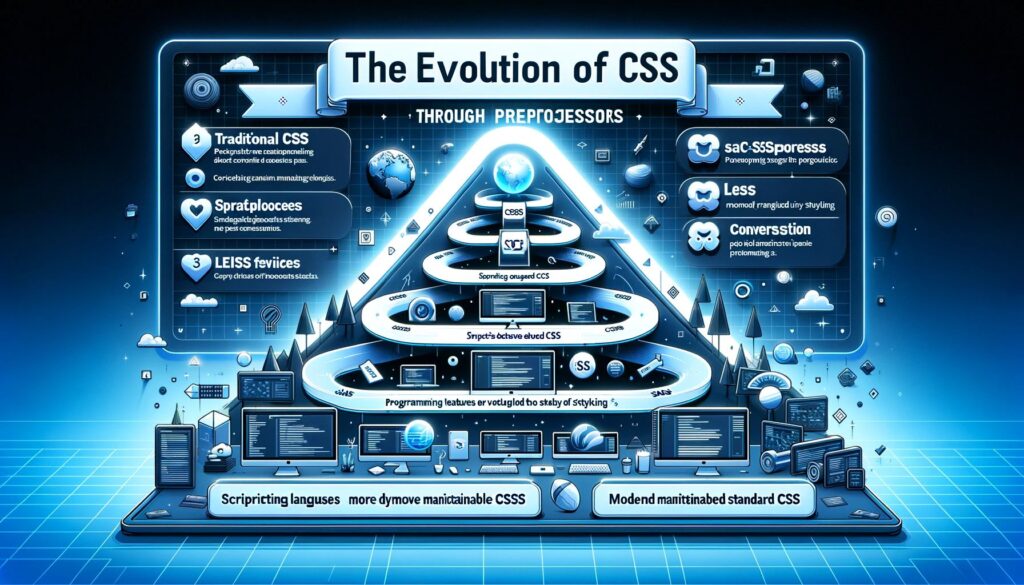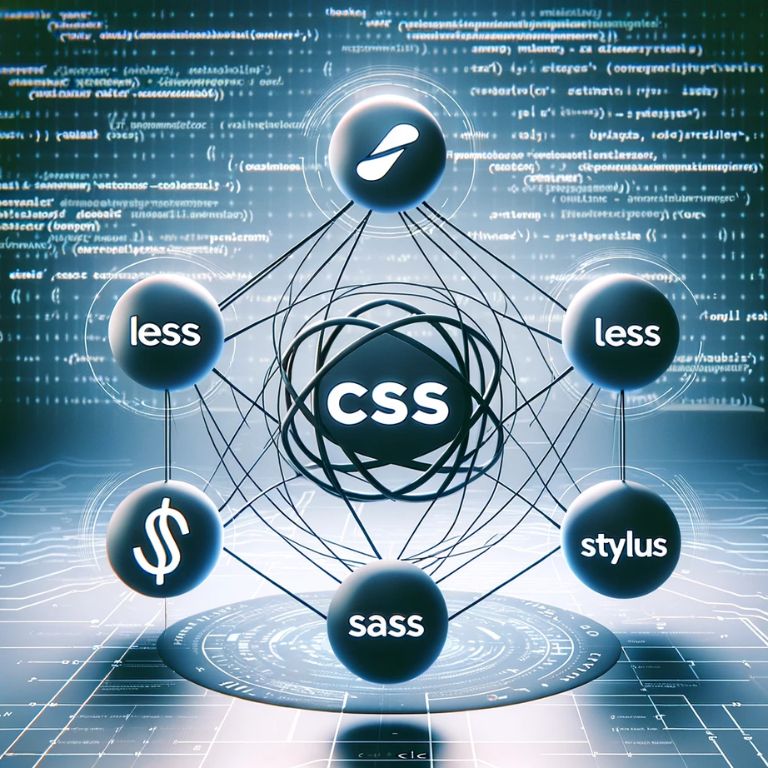Introduction to CSS Preprocessors
In the dynamic world of web development, CSS (Cascading Style Sheets) plays a pivotal role in styling and designing websites. However, as web applications become increasingly complex, managing CSS can become cumbersome due to its limitations in variables, nesting, and reusability. This is where CSS preprocessors like Sass, LESS, and Stylus come into play, offering enhanced functionality and efficiency in styling.
The Evolution of CSS Through Preprocessors
CSS preprocessors are scripting languages that extend the default capabilities of CSS. They introduce programming features into the styling process, making CSS more dynamic and maintainable. Preprocessors process the code before it is published to the web, converting it into well-formatted, standard CSS.

Key Features of CSS Preprocessors
- Variables: Preprocessors allow the use of variables for storing values such as colors, fonts, and sizes. This feature simplifies the process of making widespread style changes across a website.
- Mixins: These are reusable pieces of code that can be included in other CSS rules. Mixins make it easier to handle complex CSS features like vendor prefixes and help in reducing the repetition of code.
- Nesting: Preprocessors enable CSS rules to be nested inside one another, reflecting the hierarchical structure of HTML and making stylesheets more readable and maintainable.
- Functions and Operations: Advanced operations like color manipulation and mathematical calculations can be performed directly within stylesheets.
- Partials and Import: Large stylesheets can be broken down into smaller, more manageable files (partials) and then imported into a single file. This approach streamlines the code and aids in organization.
The Transition from Traditional CSS
While traditional CSS is straightforward and widely used, it lacks some functionalities that can expedite development and enhance maintainability. Preprocessors fill this gap by adding programming logic to CSS, making it more powerful and flexible.
For instance, a typical CSS file might contain repetitive color values or font stacks, making global changes tedious. Preprocessors address these issues by allowing developers to define these values as variables, which can be reused and easily updated.
Sass: Syntactically Awesome Style Sheets
Sass, an acronym for Syntactically Awesome Style Sheets, is a preprocessor scripting language that has been influential in the world of CSS. It extends the functionality of traditional CSS with its advanced features.
Evolution and Features
Introduced in 2006, Sass was one of the first CSS preprocessors to gain significant attention. It operates on two syntaxes: the original indentation-based syntax known as Sass, and the newer CSS-compatible syntax called SCSS (Sassy CSS). Key features of Sass include:
- Variables: Similar to programming languages, variables in Sass allow for storing and reusing values throughout stylesheets, significantly enhancing maintainability and consistency.
- Mixins: These are reusable blocks of code that can be included in other CSS rules, aiding in writing DRY (Don’t Repeat Yourself) code.
- Nesting: Sass allows CSS rules to be nested within one another, mirroring the HTML structure and making the code more readable.
- Functions and Operations: With Sass, it’s possible to define custom functions and perform various operations, particularly useful for dynamic styling.
Integration and Popularity
Sass’s popularity surged with its adoption by major frameworks like Bootstrap, which switched from LESS to Sass in its fourth version. This shift underlined Sass’s growing prominence in the web development community.
Real-world Usage Examples and Benefits
Sass is used by numerous high-profile websites and platforms due to its advanced features and robustness. The ability to write CSS in a more programming-like fashion has appealed to developers, allowing for more complex, maintainable, and scalable stylesheets.
Less: Leaner and More Efficient Styles
Less, standing for Leaner Style Sheets, emerged in 2009, offering a simpler yet powerful alternative to Sass.
Core Functionalities
Less is known for its user-friendly approach, which includes:
- Variables and Mixins: Similar to Sass, Less uses variables and mixins, although with slightly different syntax, enhancing reusability and reducing redundancy in CSS coding.
- Nesting: It supports nested rules, making the structure of CSS files more intuitive and aligned with the HTML layout.
- Functions and Operations: Less incorporates various functions, especially for manipulating colors and handling mathematical calculations.
Ease of Integration
One of Less’s advantages is its ease of integration. It can be added directly to HTML pages, and its syntax is closer to standard CSS, making the learning curve less steep.
Syntax and Popularity
Less gained popularity with its adoption by Bootstrap until version 3. Its syntax uses ‘@’ for declaring variables, differentiating it from Sass. Despite facing competition from Sass, Less remains popular due to its straightforward approach and ease of use.
Stylus: The Minimalist Preprocessor
Stylus, introduced in 2010, is known for its minimalistic approach and flexibility, offering a unique take on CSS preprocessing.
Unique Syntax and Feature Set
Stylus stands out with its flexible syntax, which can be as concise or verbose as desired. Features include:
- Variables and Mixins: Stylus provides extensive support for variables and mixins, allowing for highly dynamic stylesheets.
- Nested Selectors: It supports nested selectors, enhancing the readability and structure of CSS files.
- Functions: Stylus excels with its custom functions and extensive built-in functions for complex styling tasks.
Adoption in the Industry
While not as widely used as Sass or LESS, Stylus has carved a niche in the Node.js community and is used by various platforms for its flexibility and powerful features.
Differences from Sass and LESS
The primary difference lies in its syntax and approach to styling. Stylus’s less strict syntax can be more appealing to those who favor a more relaxed coding style, as it allows for omitting brackets, colons, and semicolons.
Comparative Analysis: Sass vs. LESS vs. Stylus
The battle among Sass, LESS, and Stylus is not just about syntax preferences but about meeting diverse project needs and developer communities. Here’s how they compare:
Strengths and Limitations
- Sass is known for its robust features and extensive community support. It offers advanced functionalities like control directives for writing complex styles. However, it requires Ruby for compilation, which can be a hurdle for some developers.
- LESS provides a simpler learning curve and is easier to integrate into projects, especially for those familiar with standard CSS. Its JavaScript-based nature makes it a go-to option for many web developers. However, it may lack some of the advanced features found in Sass.
- Stylus offers the most flexibility in syntax, appealing to developers who prefer a more expressive and concise coding style. While it is powerful and fits well within the Node.js ecosystem, its smaller community and less widespread usage can be a drawback for some.
Industry Adoption and Community Support
Sass leads in popularity and community support, partly due to its adoption by major frameworks. LESS, while having seen a decline in popularity, still holds a significant user base, particularly among those who prefer its straightforward approach. Stylus, though less popular, is praised for its flexibility and is a favorite among certain niches, especially in the Node.js community.
Decision-Making Criteria for Developers
Choosing the right preprocessor depends on several factors:
- Project Requirements: The complexity of the project and the needed features play a crucial role.
- Team Familiarity: The preprocessor that aligns with the team’s expertise and existing workflow can streamline development.
- Community and Ecosystem: A vibrant community and extensive resources can be crucial for ongoing support and learning.
The Future of CSS Preprocessors
The landscape of CSS preprocessors is continuously evolving. While native CSS is advancing with new features like custom properties, preprocessors maintain their relevance by offering functionalities beyond the scope of current CSS standards.
Advancements and Trends
The future of preprocessors might include more integration with JavaScript frameworks and better compatibility with CSS evolution. Tools like PostCSS, which allows developers to use future CSS features today, are already blending the lines between preprocessors and postprocessors.
Role in Evolving CSS and Web Design
Preprocessors have pushed the boundaries of what’s possible in CSS, influencing the development of CSS standards. As web design becomes more complex, the role of preprocessors in facilitating efficient and maintainable styling remains significant.
Conclusion and Recommendations
Sass, LESS, and Stylus have each played a pivotal role in enhancing CSS’s capabilities. They have introduced a level of dynamism and efficiency that traditional CSS lacks, addressing the growing needs of complex web development projects. The choice among these tools should be guided by project-specific requirements, team expertise, and the desired level of complexity in styling.
As web technologies continue to evolve, staying informed and adaptable is key. Developers should continue exploring these tools and choose the one that aligns best with their project goals and personal coding preferences.




